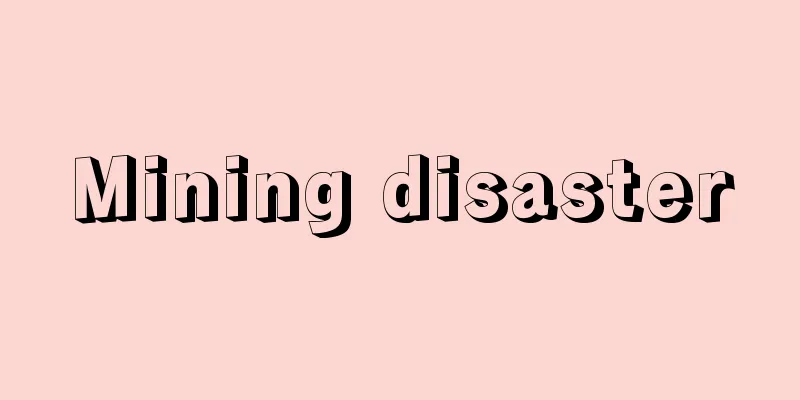Mining disaster

|
Disasters involving casualties and damage to facilities in mines. Mines have a higher accident rate than other industries because the work sites are mainly underground, and there are special disaster factors not seen in other industries. The trend in mine accidents in recent years has decreased considerably compared to 1950 (Showa 25), immediately after the enforcement of the Mine Safety Law. The number of deaths from mining work accidents in 1990 (Heisei 2) and 2008 was 44 and 8, respectively, showing a significant decrease. The reason for this is the progress of rationalization policies and scrap-and-build policies to reconstruct the coal mining industry in recent years, which have led to the successive closure of coal mines with poor management conditions and poor safety. Other factors include the establishment of safety management organizations by mining-related parties, improvement of safety technology, and heightened safety awareness. Breaking down mine disasters, the disaster rate per 1 million workers in 2000 was 39.53 in coal mines, higher than the 15.73 rate for all mines. From 1950 to May 1985, there were 55 serious disasters resulting in 10 or more fatalities. The most serious were the coal dust explosion at the Miike coal mine in November 1963 (458 fatalities) and the gas explosion at the Yamano coal mine in June 1965 (237 fatalities). Of these 55, 36 were caused by gas explosions. Other causes included mine fires, cave-ins, flooding, gas outbursts, spontaneous combustion, and coal dust explosions. Since 1985, there have been no serious disasters resulting in 10 or more fatalities. The number of deaths per year between 1990 and 2005 was between 0 and 4. The October 1981 mine fire caused by a gas outburst at the Yubari Shin Mine of the Hokutan Yubari Coal Mine (a total of 93 deaths) was a major accident that led to the abandonment of the redevelopment of the Yubari Shin Mine. The cause of the fire was that the strata near the site were 1,000 meters underground, and the geological structure contained a lot of gas. Despite several warning signs, tunnel excavation was continued without sufficient gas release. The cause of the fire is believed to have been static electricity generated by the vinyl sheet brought in by the rescue team to repair the air pipe at the time of the gas outburst, or static electricity on the body of the rescue team member. The accident investigation committee report stated that the gas explosion at the Mitsubishi Minami Oyubari Coal Mine in May 1985, which killed 62 people, was caused by a similar cause. Coal mine disasters have decreased dramatically in Japan, but looking at the world, there were five explosions in China alone in 2005 that killed more than 25 people, and in February of that year, an explosion at the Sunjiawan coal mine in Liaoning Province killed or left missing more than 200 people. In addition, a cave-in at the San Jose mine in Chile in August 2010 attracted worldwide attention when all 33 people were rescued 70 days after the incident. [Toshiro Kuroiwa] Distinction of mining disastersMine disasters are divided into major disasters and frequent disasters. [Toshiro Kuroiwa] Major disastersA disaster that causes many casualties and has the potential to cause great damage to mining facilities and mineral resources is called a major disaster. Among them, a disaster that causes three or more deaths or five or more casualties is called a severe disaster. Major disasters include the following: (1) Gas explosion: When methane produced from coal beds is mixed with air in the range of 5 to 15%, it becomes explosive. (2) Coal Dust Explosion: When coal dust is suspended in the air in a volume of 50 to 1,500 grams per cubic meter, it becomes explosive. (3) Gas outburst: A large amount of methane suddenly erupts during tunnel excavation, causing a disaster. (4) Mine Fires Mine fires caused by spontaneous combustion or other factors often become major disasters. (5) Water seepage Water may seep into the mine from underground water veins, old mine sites filled with water, the seabed, etc. [Toshiro Kuroiwa] Frequent disastersThe following types of disasters, which occur very frequently and account for 80 to 85% of the total number of mine disasters and victims, although the number of casualties per disaster is small and the severity of the disaster is low, are called frequent disasters. (1) Rockfall: A disaster caused by the roof or side walls collapsing during mining. (2) Transportation Accidents There are surprisingly many accidents involving shaft ropes breaking or being trapped between mine cars. (3) Flying stones and rolling stones Accidents caused by flying stones or rolling stones from the side during mining. Although not classified as a frequent disaster, mines do have unique disasters, such as accidents that occur while handling explosives or during blasting operations, as well as gas poisoning and suffocation due to oxygen deficiency. [Toshiro Kuroiwa] Prevention of mine disastersMining disasters often occur due to a combination of factors. For example, if the mine is filled with methane, that alone does not cause a major disaster. An effective mixture ratio and various other factors are necessary to prevent an explosion. These factors must be eliminated one by one to maintain the highest level of safety inside the mine. To prevent mining disasters and ensure safety, it is most important for mines to make independent efforts. Supervision and guidance of this is handled by the Nuclear and Industrial Safety Agency (Mine Safety Division) of the Ministry of Economy, Trade and Industry, and local Industrial Safety Inspection Departments. [Toshiro Kuroiwa] [References] | | | | | | | | |Source: Shogakukan Encyclopedia Nipponica About Encyclopedia Nipponica Information | Legend |
|
鉱山における死傷者、施設の破損などを伴う災害。鉱山は、おもに作業場が地下にあるため、他産業にみられない特殊な災害要因があり、他産業よりも災害率が高い。近年の鉱山災害の傾向は、鉱山保安法が施行された直後の1950年(昭和25)当初に比べればかなり減少している。1990年(平成2)および2008年における鉱業労働災害死亡者数はそれぞれ44人と8人であり、大幅な減少を示している。その要因として、近年の石炭鉱業再建のための合理化政策、スクラップ・アンド・ビルド政策の進行のため、経営条件の悪い炭鉱、保安不良の炭鉱の閉山が相次いだことがあげられるが、そのほかに、鉱山関係者による保安管理組織の整備、保安技術の向上、保安意識の高揚などをあげることができる。 鉱山災害の内訳をみると、2000年の稼動延べ100万人当りの災害率では、石炭鉱山では39.53と、全鉱山での15.73に比べて高くなっている。1950年以降1985年5月まで、死亡者10人以上の重大災害は55回発生した。そのなかで1963年11月、三池炭鉱の炭塵(たんじん)爆発(死亡者数458人)、1965年6月、山野炭鉱で発生したガス爆発(死亡者数237人)はもっとも大きな災害であった。この55回のうち36回はガス爆発によって起こっている。そのほか坑内火災、落盤、坑内出水、ガス突出、自然発火、炭塵爆発の原因によって生じている。1985年以降は、死亡者10名以上の重大災害は発生していない。1990~2005年の年間死亡者数は0~4人である。 1981年10月の北炭夕張炭鉱夕張新鉱のガス突出による坑内火災(死亡者計93人)は夕張新鉱の再開発を断念させるに至る大事故であった。その原因としては、現場付近の地層が地下1000メートルの深部で、地質構造的に包蔵ガスが多く、いくつかの予兆があったにもかかわらず、ガス抜き不十分なまま坑道掘進を進めたことがあげられる。また火災原因については、ガス突出時に救護隊が圧気管修理のために持ち込んだビニルシートが発生させた静電気か、隊員の身体への帯電であろうと推定されている。1985年5月の死亡者62人を出した三菱(みつびし)・南大夕張炭礦(たんこう)のガス爆発事故もほぼ同様の原因によるという事故調査委員会の報告が提出されている。日本では激減した炭鉱災害だが、世界的にみると、2005年に中国に限っても死者25名以上の爆発事故が5件起きており、同年2月の遼寧(りょうねい/リヤオニン)省孫家湾炭鉱の爆発事故では死者・行方不明者が200名以上に達した。また、2010年8月に起きたチリのサンホセ鉱山の落盤事故では、発生から70日ぶりに33人全員が救出され、世界中の注目を集めた。 [黒岩俊郎] 鉱山災害の区別鉱山災害は、重要災害と頻発災害とに区別される。 [黒岩俊郎] 重要災害多数の死傷者を出し、また鉱山施設や鉱物資源に多大の損害を与えるおそれのある災害を重要災害とよんでいる。そのなかで死亡者3人以上または死傷者5人以上を発生した災害をとくに重大災害とよんでいる。重要災害には次のようなものがある。 (1)ガス爆発 炭層から生じるメタンが5~15%の範囲で空気と混合した場合、爆発性となる。 (2)炭塵爆発 空中に浮遊する炭塵が1立方メートル中50~1500グラムの場合、爆発性を帯びる。 (3)ガス突出 坑道掘進中などに突然大量のメタンが噴出、それに伴って災害が生じる。 (4)坑内火災 自然発火やその他の原因による坑内火災は、しばしば大災害になりやすい。 (5)出水 地下の水脈や水の満ちた旧採掘跡、海底などから坑内へ水が浸入する場合がある。 [黒岩俊郎] 頻発災害1回当りの死傷者数も少なく、また災害の程度も低いが、発生回数が非常に多く、鉱山の災害件数、罹災者数の80~85%を占める次のような災害を頻発災害とよんでいる。 (1)落盤 採掘中、天盤や側壁などが落下崩壊することによる災害。 (2)運搬事故 立坑(たてこう)のロープが切断したり鉱車に挟まれるなどの災害が意外に多い。 (3)飛石・転石 採掘中の飛石や側面からの転石による災害。 頻発災害には入らないが、鉱山では、火薬の取扱い中や発破(はっぱ)作業中に発生する事故や、ガス中毒や酸素欠乏による窒息など、特有の災害がある。 [黒岩俊郎] 鉱山災害の防止鉱山災害は、多くの場合、いろいろの原因が交錯して起こる。たとえば、坑内にメタンが充満してもそれだけでは大災害にならない。爆発に有効な混合比、その他種々の要素が必要である。その要素を一つずつ除去して、坑内を最高水準の保安状態に保つことが必要である。鉱山災害を防止し、保安を確保するために、鉱山の自主的な努力がなにより必要である。これの監督指導には、経済産業省に置かれている原子力安全・保安院(鉱山保安課)および地方の産業保安監督部があたっている。 [黒岩俊郎] [参照項目] | | | | | | | | |出典 小学館 日本大百科全書(ニッポニカ)日本大百科全書(ニッポニカ)について 情報 | 凡例 |
Recommend
Kamiizumi-ryu
…Years of birth and death unknown. He is the foun...
Rozenfel'd, LB (English notation)RozenfeldLB
…Soviet revolutionary and politician. His real na...
Isshikida - Isshikida
A type of cultivated land that makes up a manor, ...
"Kan'ei Hakozaki Bunko"
… [Kikuo Noguchi] [Kuroda's Noisy Animals] No...
Marsh, Othniel Charles
Born October 29, 1831 in Lockport, New York. [Died...
Edgar Quinet
1803‐75 French historian. While studying at the Un...
Grévin, Jacques
[Born] 1538 [Died] November 5, 1570, Turin. French...
Olympic Games
…Abbreviation for the Olympic Games. In Japan, it...
Erosional terrace (English spelling) Erosional terrace
… Terraces are classified into rock terraces (mad...
Myenteric plexus - myenteric plexus
→ Auerbach's plexus Source: Asakura Publishing...
Lycoris albiflora (English spelling)
…[Tetsuichi Yahara]. … *Some of the terminology t...
Tea whisk - Chasen
A bamboo whisk used to prepare matcha tea. It is ...
Sun Simiao - Sonshibaku
A physician from the Sui and Tang dynasties of Ch...
Blood -
The red fluid tissue that flows through the blood...
Odd Eyes - Odd Eyes (English spelling)
Heterochromia is when the eyes are different color...









